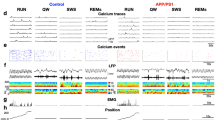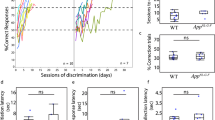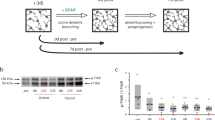Abstract
We show that a natural behavior, exploration of a novel environment, causes DNA double-strand breaks (DSBs) in neurons of young adult wild-type mice. DSBs occurred in multiple brain regions, were most abundant in the dentate gyrus, which is involved in learning and memory, and were repaired within 24 h. Increasing neuronal activity by sensory or optogenetic stimulation increased neuronal DSBs in relevant but not irrelevant networks. Mice transgenic for human amyloid precursor protein (hAPP), which simulate key aspects of Alzheimer's disease, had increased neuronal DSBs at baseline and more severe and prolonged DSBs after exploration. Interventions that suppress aberrant neuronal activity and improve learning and memory in hAPP mice normalized their levels of DSBs. Blocking extrasynaptic NMDA-type glutamate receptors prevented amyloid-β (Aβ)-induced DSBs in neuronal cultures. Thus, transient increases in neuronal DSBs occur as a result of physiological brain activity, and Aβ exacerbates DNA damage, most likely by eliciting synaptic dysfunction.
This is a preview of subscription content, access via your institution
Access options
Subscribe to this journal
Receive 12 print issues and online access
$209.00 per year
only $17.42 per issue
Buy this article
- Purchase on Springer Link
- Instant access to full article PDF
Prices may be subject to local taxes which are calculated during checkout








Similar content being viewed by others
References
Brasnjevic, I., Hof, P.R., Steinbusch, H.W. & Schmitz, C. Accumulation of nuclear DNA damage or neuron loss: molecular basis for a new approach to understanding selective neuronal vulnerability in neurodegenerative diseases. DNA Repair (Amst.) 7, 1087–1097 (2008).
Moreira, P.I. et al. Nucleic acid oxidation in Alzheimer disease. Free Radic. Biol. Med. 44, 1493–1505 (2008).
Lu, T. et al. Gene regulation and DNA damage in the ageing human brain. Nature 429, 883–891 (2004).
Bonner, W.M. et al. γH2AX and cancer. Nat. Rev. Cancer 8, 957–967 (2008).
Ismail, I.H. & Hendzel, M.J. The γ-H2A.X: is it just a surrogate marker of double-strand breaks or much more? Environ. Mol. Mutagen. 49, 73–82 (2008).
Kim, D. et al. Deregulation of HDAC1 by p25/Cdk5 in neurotoxicity. Neuron 60, 803–817 (2008).
Fernandez-Capetillo, O. et al. H2AX is required for chromatin remodeling and inactivation of sex chromosomes in male mouse meiosis. Dev. Cell 4, 497–508 (2003).
Lee, S.Y. et al. Histone XH2AX is required for Xenopus anterior neural development: critical role of threonine 16 phosphorylation. J. Biol. Chem. 285, 29525–29534 (2010).
Yin, B. et al. Histone H2AX stabilizes broken DNA strands to suppress chromosome breaks and translocations during V(D)J recombination. J. Exp. Med. 206, 2625–2639 (2009).
Fernando, R.N. et al. Cell cycle restriction by histone H2AX limits proliferation of adult neural stem cells. Proc. Natl. Acad. Sci. USA 108, 5837–5842 (2011).
Crowe, S.L., Movsesyan, V.A., Jorgensen, T.J. & Kondratyev, A. Rapid phosphorylation of histone H2A.X following ionotropic glutamate receptor activation. Eur. J. Neurosci. 23, 2351–2361 (2006).
Crowe, S.L., Tsukerman, S., Gale, K., Jorgensen, T.J. & Kondratyev, A.D. Phosphorylation of histone H2A.X as an early marker of neuronal endangerment following seizures in the adult rat brain. J. Neurosci. 31, 7648–7656 (2011).
Palop, J.J. et al. Vulnerability of dentate granule cells to disruption of Arc expression in human amyloid precursor protein transgenic mice. J. Neurosci. 25, 9686–9693 (2005).
Vazdarjanova, A. et al. Spatial exploration induces ARC, a plasticity-related immediate-early gene, only in calcium/calmodulin-dependent protein kinase II-positive principal excitatory and inhibitory neurons of the rat forebrain. J. Comp. Neurol. 498, 317–329 (2006).
Cheng, I.H. et al. Accelerating amyloid-β fibrillization reduces oligomer levels and functional deficits in Alzheimer disease mouse models. J. Biol. Chem. 282, 23818–23828 (2007).
Palop, J.J. et al. Neuronal depletion of calcium-dependent proteins in the dentate gyrus is tightly linked to Alzheimer's disease-related cognitive deficits. Proc. Natl. Acad. Sci. USA 100, 9572–9577 (2003).
Palop, J.J. et al. Aberrant excitatory neuronal activity and compensatory remodeling of inhibitory hippocampal circuits in mouse models of Alzheimer's disease. Neuron 55, 697–711 (2007).
Palop, J.J. & Mucke, L. Amyloid-beta-induced neuronal dysfunction in Alzheimer's disease: from synapses toward neural networks. Nat. Neurosci. 13, 812–818 (2010).
Roberson, E.D. et al. Reducing endogenous tau ameliorates amyloid β-induced deficits in an Alzheimer's disease mouse model. Science 316, 750–754 (2007).
Götz, J. & Ittner, L.M. Animal models of Alzheimer's disease and frontotemporal dementia. Nat. Rev. Neurosci. 9, 532–544 (2008).
Kobayashi, D.T. & Chen, K.S. Behavioral phenotypes of amyloid-based genetically modified mouse models of Alzheimer's disease. Genes Brain Behav. 4, 173–196 (2005).
Marchetti, C. & Marie, H. Hippocampal synaptic plasticity in Alzheimer's disease: what have we learned so far from transgenic models? Rev. Neurosci. 22, 373–402 (2011).
Lange, J. et al. ATM controls meiotic double-strand-break formation. Nature 479, 237–240 (2011).
Fillingham, J., Keogh, M.C. & Krogan, N.J. γH2AX and its role in DNA double-strand break repair. Biochem. Cell Biol. 84, 568–577 (2006).
Anderson, L., Henderson, C. & Adachi, Y. Phosphorylation and rapid relocalization of 53BP1 to nuclear foci upon DNA damage. Mol. Cell Biol. 21, 1719–1729 (2001).
Ward, I.M., Minn, K., Jorda, K.G. & Chen, J. Accumulation of checkpoint protein 53BP1 at DNA breaks involves its binding to phosphorylated histone H2AX. J. Biol. Chem. 278, 19579–19582 (2003).
Olive, P.L. & Banath, J.P. The comet assay: a method to measure DNA damage in individual cells. Nat. Protoc. 1, 23–29 (2006).
Flint, M.S., Baum, A., Chambers, W.H. & Jenkins, F.J. Induction of DNA damage, alteration of DNA repair and transcriptional activation by stress hormones. Psychoneuroendocrinology 32, 470–479 (2007).
Harris, J.A. et al. Transsynaptic progression of amyloid-β-induced neuronal dysfunction within the entorhinal-hippocampal network. Neuron 68, 428–441 (2010).
Roberson, E.D. et al. Amyloid-β/Fyn-induced synaptic, network, and cognitive impairments depend on Tau levels in multiple mouse models of Alzheimer's disease. J. Neurosci. 31, 700–711 (2011).
Verret, L. et al. Inhibitory interneuron deficit links altered network activity and cognitive dysfunction in Alzheimer model. Cell 149, 708–721 (2012).
Palop, J.J. & Mucke, L. Epilepsy and cognitive impairments in Alzheimer disease. Arch. Neurol. 66, 435–440 (2009).
Morris, M., Maeda, S., Vossel, K. & Mucke, L. The many faces of tau. Neuron 70, 410–426 (2011).
Sanchez, P.E. et al. Levetiracetam suppresses neuronal network dysfunction and reverses synaptic and cognitive deficits in an Alzheimer's disease model. Proc. Natl. Acad. Sci. USA 109, E2895–E2903 (2012).
Hardingham, G.E. & Bading, H. Synaptic versus extrasynaptic NMDA receptor signalling: implications for neurodegenerative disorders. Nat. Rev. Neurosci. 11, 682–696 (2010).
Li, S. et al. Soluble Aβ oligomers inhibit long-term potentiation through a mechanism involving excessive activation of extrasynaptic NR2B-containing NMDA receptors. J. Neurosci. 31, 6627–6638 (2011).
Shull, E.R. et al. Differential DNA damage signaling accounts for distinct neural apoptotic responses in ATLD and NBS. Genes Dev. 23, 171–180 (2009).
Bhogal, N., Jalali, F. & Bristow, R.G. Microscopic imaging of DNA repair foci in irradiated normal tissues. Int. J. Radiat. Biol. 85, 732–746 (2009).
Grudzenski, S., Raths, A., Conrad, S., Rube, C.E. & Lobrich, M. Inducible response required for repair of low-dose radiation damage in human fibroblasts. Proc. Natl. Acad. Sci. USA 107, 14205–14210 (2010).
Canugovi, C. et al. Endonuclease VIII-like 1 (NEIL1) promotes short-term spatial memory retention and protects from ischemic stroke-induced brain dysfunction and death in mice. Proc. Natl. Acad. Sci. USA 109, 14948–14953 (2012).
Zhang, Y., Goodyer, C. & LeBlanc, A. Selective and protracted apoptosis in human primary neurons microinjected with active caspase-3,-6,-7, and -8. J. Neurosci. 20, 8384–8389 (2000).
Lee, H.G. et al. Cell cycle re-entry mediated neurodegeneration and its treatment role in the pathogenesis of Alzheimer's disease. Neurochem. Int. 54, 84–88 (2009).
Li, L., Cheung, T., Chen, J. & Herrup, K. A comparative study of five mouse models of Alzheimer's disease: cell cycle events reveal new insights into neurons at risk for death. Int. J. Alzheimers Dis. 2011, 171464 (2011).
Morris, M. et al. Age-appropriate cognition and subtle dopamine-independent motor deficits in aged Tau knockout mice. Neurobiol. Aging doi:10.1016/j.neurobiolaging.2012.12.003 (16 January 2013).
Cissé, M. et al. Reversing EphB2 depletion rescues cognitive functions in Alzheimer model. Nature 469, 47–52 (2011).
Li, S. et al. Soluble oligomers of amyloid β-protein facilitate hippocampal long-term depression by disrupting neuronal glutamate uptake. Neuron 62, 788–801 (2009).
Esposito, L. et al. Reduction in mitochondrial superoxide dismutase modulates Alzheimer's disease-like pathology and accelerates the onset of behavioral changes in human amyloid precursor protein transgenic mice. J. Neurosci. 26, 5167–5179 (2006).
Yang, J.L., Tadokoro, T., Keijzers, G., Mattson, M.P. & Bohr, V.A. Neurons efficiently repair glutamate-induced oxidative DNA damage by a process involving CREB-mediated up-regulation of apurinic endonuclease 1. J. Biol. Chem. 285, 28191–28199 (2010).
Day, J.J. & Sweatt, J.D. Epigenetic mechanisms in cognition. Neuron 70, 813–829 (2011).
Gräff, J., Kim, D., Dobbin, M.M. & Tsai, L.H. Epigenetic regulation of gene expression in physiological and pathological brain processes. Physiol. Rev. 91, 603–649 (2011).
Cheng, J.S. et al. Collagen VI protects neurons against Aβ toxicity. Nat. Neurosci. 12, 119–121 (2009).
Kravitz, A.V. et al. Regulation of parkinsonian motor behaviours by optogenetic control of basal ganglia circuitry. Nature 466, 622–626 (2010).
Spink, A.J., Tegelenbosch, R.A.J., Buma, M.O.S. & Noldus, L.P.J.J. The EthoVision video tracking system—a tool for behavioral phenotyping of transgenic mice. Physiol. Behav. 73, 731–744 (2001).
Pong, K., Doctrow, S.R., Huffman, K., Adinolfi, C.A. & Baudry, M. Attenuation of staurosporine-induced apoptosis, oxidative stress, and mitochondrial dysfunction by synthetic superoxide dismutase and catalase mimetics, in cultured cortical neurons. Exp. Neurol. 171, 84–97 (2001).
Rong, Y., Doctrow, S.R., Tocco, G. & Baudry, M. EUK-134, a synthetic superoxide dismutase and catalase mimetic, prevents oxidative stress and attenuates kainate-induced neuropathology. Proc. Natl. Acad. Sci. USA 96, 9897–9902 (1999).
Pinheiro, J., Bates, D., DebRoy, S., Sarkar, D. & R Development Core Team. nlme: linear and nonlinear mixed effects models. R package version 3.1-102 (2011).
Acknowledgements
We thank D.J. Selkoe (Harvard Medical School) and D.M. Walsh (Conway Institute and University College Dublin) for CHO-7PA2 cells; N. Sakane, E. Verdin and L. Verret for comments on the manuscript; H. Kassler for advice on γ-irradiation; D. Davalos for advice on confocal imaging; D. Pathak for advice on live cell imaging; H. Solanoy, M. Thwin, C. Wang and G.-Q. Yu for technical support; A.L. Lucido for editorial review; J. Carroll, T. Roberts, G. Maki and C. Goodfellow for preparation of graphics; and M. Dela Cruz for administrative assistance. The study was supported by US National Institutes of Health grants AG011385, AG022074 and NS065780 to L.M. and a gift from the S.D. Bechtel, Jr. Foundation.
Author information
Authors and Affiliations
Contributions
E.S. designed and conducted behavioral, immunohistochemical and biochemical analyses. P.E.S. designed and carried out levetiracetam treatments and stress-related studies. A.V.K. designed and conducted optogenetic experiments. X.W. and K.H. provided technical assistance for biochemical analyses. K.E. contributed to statistical analyses. N.D. helped design behavioral experiments. A.C.K. supervised the optogenetic experiments. E.S. and L.M. analyzed and interpreted data and wrote the manuscript. L.M. conceived, supervised and provided funding for the study.
Corresponding author
Ethics declarations
Competing interests
L.M. serves on scientific advisory boards of iPierian and Neuropore Therapies and has received funding for other research projects from Bristol-Myers Squibb and Takeda Pharmaceuticals.
Supplementary information
Supplementary Text and Figures
Supplementary Figures 1–8 (PDF 1128 kb)
Rights and permissions
About this article
Cite this article
Suberbielle, E., Sanchez, P., Kravitz, A. et al. Physiologic brain activity causes DNA double-strand breaks in neurons, with exacerbation by amyloid-β. Nat Neurosci 16, 613–621 (2013). https://doi.org/10.1038/nn.3356
Received:
Accepted:
Published:
Issue Date:
DOI: https://doi.org/10.1038/nn.3356
This article is cited by
-
Formation of memory assemblies through the DNA-sensing TLR9 pathway
Nature (2024)
-
Alexey Olovnikov: theoretical biology beyond the margins
Biogerontology (2024)
-
Detection of neuronal OFF periods as low amplitude neural activity segments
BMC Neuroscience (2023)
-
Sting and p53 DNA repair pathways are compromised in Alzheimer’s disease
Scientific Reports (2023)
-
Age, sex, and apolipoprotein E isoform alter contextual fear learning, neuronal activation, and baseline DNA damage in the hippocampus
Molecular Psychiatry (2023)



